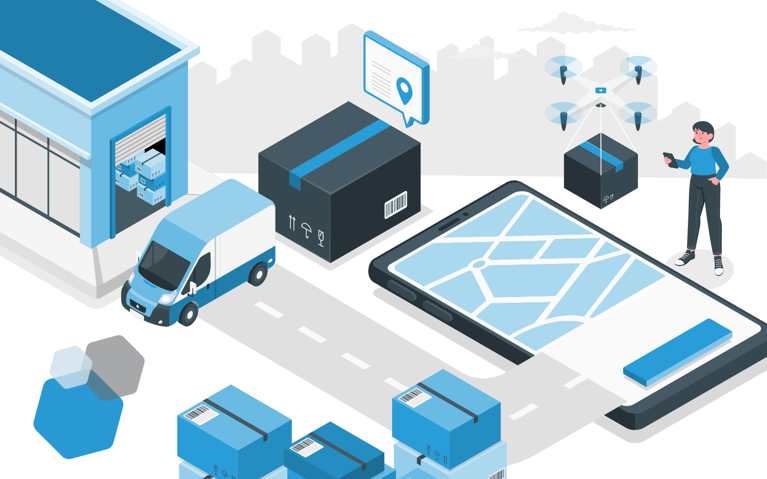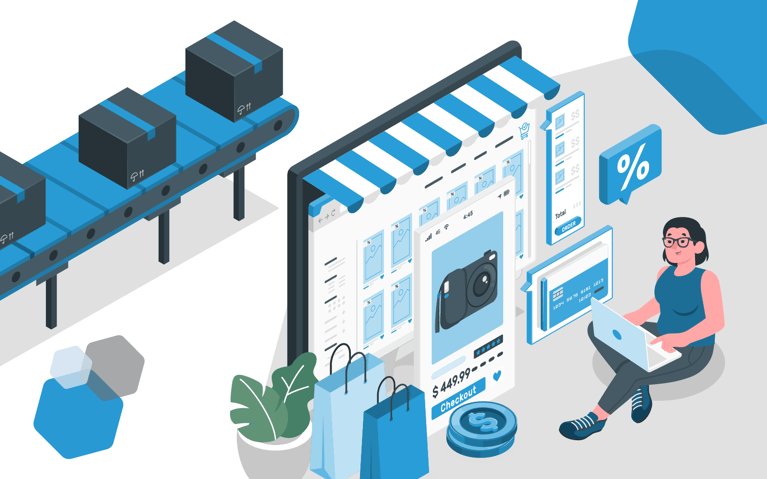Originally posted September 2, 2022, updated May 22, 2024 by A. Wolfe.
Your customers’ experience with your business is the key to long-term success, and in the world of retail, ecommerce order fulfillment is particularly vital. Today’s customers have expectations about how much shipping should cost an how fast their order should get there. After all, nobody wants to wait too long for something they ordered online; or wonder if it will turn up at all.
What is order fulfillment?
Order fulfillment, by definition, are the processes retailers use to complete sales orders and deliver products to customers. Fulfillment is a big part of your brand's personality. Expediency, specificity and communication are the tenants of any scalable order fulfillment strategy.
Fulfillment can be challenging, but it doesn’t have to be. By optimizing your order fulfillment strategy, you can save on operational costs, improve customer satisfaction and avoid some of the biggest headaches involved in operating as an omnichannel commerce brand.
The purpose of a streamlined order fulfillment strategy
Order fulfillment without a strategy can lead to significant friction, wasted time and excessive costs. On the other hand, optimizing your order fulfillment process can benefit you in several ways:
- Decrease shipping costs: Shipping costs can eat into your profitability. However, passing those costs down to the consumer makes it difficult to compete with brands that offer free shipping. When you build an optimized order fulfillment strategy, shipping costs should be a central focus. This means investigating what affects your shipping costs, and looking at the different shipping providers, reviewing the costs of various shipping services and choosing the best option for each product you sell. When shipping costs are optimized, it can save you significantly in the long run.
- Improve inventory management: Inventory can quickly get out of hand when you operate an ecommerce platform, costing you both time and money. Mishaps affecting your inventory can even cause you to lose sales, putting a ceiling on your top-line revenue. A solid order fulfillment strategy addresses inventory management, including demand predictions and avoiding overstock and stockouts. Optimization inventory management can increase sales and reduce storage costs.
- Increase fulfillment rate: A fulfillment rate measures the percentage of orders successfully completed and shipped to customers within a given time frame. When it’s optimized, it means you’ve streamlined inventory management, implemented efficient order processing systems and consistently analyze fulfillment data to identify and address bottlenecks in the supply chain. When your strategy is strong, a high fulfillment rate is the result.
- Create a better customer experience: What does order fulfillment mean to your customers? Everything! Human beings crave instant gratification, especially when shopping. That makes order fulfillment a big part of customer service and the customer experience. The faster and more efficiently your customers can get the gratification they crave, the better your customer satisfaction scores are likely to be. By optimizing your order fulfillment strategy, you can make your customers happier, drive sales and ultimately increase your earnings.
10 ways to improve fulfillment operations for your business
If your order fulfillment process hasn’t been optimized, it’s time to make a change. There are numerous benefits to maximizing your order fulfillment that, including reducing operational costs, boosting overall efficiency and profitability and improving customer satisfaction. Here are 10 ways you can start to improve your omnichannel fulfillment process immediately:
1. Invest in fulfillment software to provide better visibility
Investing in the right fulfillment software is crucial for streamlining operations, enhancing efficiency and meeting customer demands. An Order Management System (OMS) is a software solution that centralizes and automates order processing from various sales channels. It allows businesses to efficiently manage orders throughout the entire order lifecycle, from placement to fulfillment and delivery. By providing real-time visibility into inventory levels, order statuses and customer data, an OMS enables businesses to optimize inventory allocation, streamline order processing, minimize stockouts and enhance customer satisfaction. An OMS benefits fulfillment operations by improving efficiency, accuracy and agility in managing orders across multiple channels.
For businesses with complex supply chains, a robust enterprise resource planning (ERP) system can centralize data, optimize resource allocation and facilitate seamless communication between different departments and stakeholders. Furthermore, investing in a Warehouse Management System (WMS) can optimize warehouse layout, streamline picking and packing processes and improve inventory accuracy, leading to faster order fulfillment and reduced errors. Many 3PLs have a WMS that integrates with other retail software.
2. Be strategic with your warehouse layout
A strategic warehouse layout offers several benefits, including optimized space utilization, streamlined workflows, reduced labor costs, improved inventory management and enhanced safety. To create an effective and optimized warehouse layout, conduct a thorough analysis of your inventory, order volume and workflow processes. Consider factors such as product size, weight and velocity when designing storage areas and shelving configurations. Implement efficient picking paths and zone picking strategies to minimize travel time and increase productivity. Utilize technologies like warehouse management systems (WMS) and automation solutions to further optimize operations and maximize the benefits of your strategic layout. Regularly review and adjust the layout based on evolving business needs and operational performance metrics to ensure ongoing efficiency and effectiveness.
3. Identify your shipping capacity
Identifying your shipping capacity is crucial for timely order fulfillment and customer satisfaction. Evaluate your current shipping infrastructure, including carrier partnerships, transportation modes and shipping zones. Determine the maximum number of orders you can process within a given time frame based on factors like warehouse capacity, labor availability and order processing capabilities. Analyze historical shipping data and sales forecasts to anticipate peak periods and seasonal fluctuations in demand, allowing you to scale your shipping capacity accordingly. Consider investing in technology solutions like shipping management software and automated shipping processes to streamline operations and increase efficiency. Continuously monitor and adjust your shipping capacity in response to changing demand patterns, market trends and business growth to optimize performance and meet customer expectations.
4. Pinpoint areas in the fulfillment process that take too much time
Order fulfillment is about speed and accuracy. While efficient fulfillment processes benefits customer, it’s important for businesses too. Analyze each step in the order fulfillment workflow. This assessment should identify bottlenecks, inefficiencies and areas where manual intervention is required. By pinpointing these processes, businesses can uncover opportunities to streamline operations, reduce processing times and improve overall efficiency. This optimization not only accelerates order processing and fulfillment but also minimizes the risk of delays, errors and customer dissatisfaction. It also allows companies to allocate resources more effectively, prioritize improvements and invest in automation or technology solutions where necessary, ultimately improving competitiveness and profitability.
5. Consider your shipping options
When considering your fulfillment shipping options, it's essential to assess various factors such as shipping speed, cost, reliability and the specific needs of your customers and products. Look at your target market's preferences and expectations regarding delivery times and shipping costs. Evaluate the available shipping carriers and services to determine which ones align best with your business requirements, including product needs such as assembly, size, time sensitivity, fragility and temperature control. Negotiate rates with carriers based on your shipping volume and frequency to secure competitive pricing, or if you use a 3PL, let them do that. Factor in shipping insurance, tracking capabilities and any additional services offered by carriers to ensure the safe and timely delivery of orders. Regularly review and adjust your shipping strategy as your business grows and customer expectations evolve, maintaining a balance between cost-effectiveness and customer satisfaction.
6. Address returns management
Returns management is part of order fulfillment as it directly impacts customer satisfaction, brand reputation and cashflow. Effective returns management processes not only facilitate smooth handling of product returns but also provide valuable insights into product quality, customer preferences and areas for improvement. Your brand will need to clearly outline your return policy, including return reasons, timelines and procedures. Streamline the returns process by offering multiple return options, such as prepaid labels or in-store returns, to accommodate diverse customer needs. Utilize technology solutions like return management software to automate and track the returns process and establish dedicated return handling facilities or designated areas within warehouses to efficiently process returned items and minimize restocking delays. It’s also critical to prioritize communication with customers throughout the returns process, providing timely updates and resolutions to ensure a positive experience and foster long-term loyalty.
7. Evaluate your packaging
Packaging makes a difference in your fulfillment operations. It can help reduce shipping costs by minimizing dimensional (DIM) weight and excess packaging materials. Efficient packaging boosts sustainability efforts by reducing waste and environmental impact. In addition, proper packaging protects products from damage during transit, reducing returns and associated costs. Ensure your packaging is an ideal balance of aesthetically pleasing, functional and cost-effective.
8. Look at scalability
Because of the rapidly changing retail dynamics, scalability is crucial for order fulfillment. It allows businesses to adapt to fluctuations in demand and growth without compromising efficiency or customer service. By having scalable fulfillment operations, businesses can easily handle sudden spikes in orders during peak seasons or periods of rapid growth without experiencing bottlenecks or delays. Assessing scalability requires evaluating various aspects of fulfillment, including warehouse space, technology infrastructure, staffing levels and logistics capabilities. Businesses can assess scalability by analyzing historical sales data to identify trends and forecast future demand, conducting capacity planning to determine if current resources can support projected growth and investing in flexible systems and processes that can easily accommodate changes in volume or complexity.
9. Understand your fulfillment needs
By understanding your fulfillment needs, businesses can develop strategies to optimize their operations for efficiency, scalability, and customer satisfaction. When identifying fulfillment needs, consider:
- Order volume: Assess the current and projected order volume to determine the capacity required to fulfill orders efficiently.
- Product characteristics: Consider the size, weight and fragility of products, as well as any special handling requirements, to ensure they can be stored and shipped safely.
- Shipping locations: Determine the geographic distribution of customers and shipping destinations to optimize inventory placement and reduce shipping costs and transit times.
- Seasonality: Take into account seasonal fluctuations in demand to ensure that fulfillment operations can scale up or down as needed to meet peak periods.
- Technology infrastructure: Evaluate existing technology systems and capabilities, such as order management, inventory management and shipping software, to determine if they can support current and future fulfillment needs.
- Customer expectations: Consider customer expectations for shipping speed, accuracy, and flexibility to ensure that fulfillment operations align with service level agreements and enhance the overall customer experience.
- Budget: Assess the budget available for fulfillment operations, including costs related to warehousing, labor, technology and shipping, to determine the most cost-effective solution that meets business requirements.
10. Plan ahead for seasonal sales spikes
Prepare yourself for sales cycles. For example, most online businesses will experience sales spikes during the holiday season as consumers purchase gifts or take advantage of sales. Analyze historical sales data to identify patterns and anticipate peak periods. Plan ahead so that inventory levels are sufficient to meet increased demand by implementing strategies such as safety stock and just-in-time inventory management. You can also prepare fulfillment operations by optimizing staffing, warehouse capacity and shipping logistics to handle higher order volumes efficiently during peak periods.
Improve your order fulfillment today
A 3PL provider can help maximize order fulfillment strategy by offering expertise, resources and infrastructure for efficient logistics operations. They can handle various aspects of the fulfillment process, including warehousing, inventory management, picking and packing and shipping, allowing businesses to focus on core activities. Many 3PLs ohave advanced technology and software solutions to optimize processes, track shipments and provide real-time visibility into inventory and order status. By leveraging the capabilities of a 3PL, businesses can enhance scalability, reduce costs, improve customer satisfaction and streamline their overall fulfillment operations. Contact Cart.com today to see how we can improve you retail operations from discovery to delivery.









